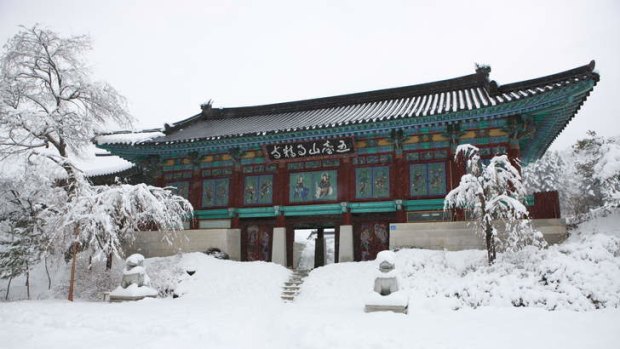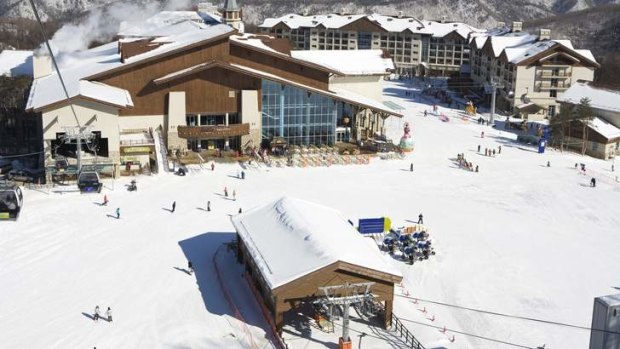
The Woljeongsa Buddhist Temple near Mount Odaesan.
Its little-known ski industry offers plenty of snow, few crowds and many attractions on and off the slopes, writes Susan Bredow.
It’s when I’m resting quietly and alone, having paused in a beautiful forest of pine, oak and maple at 700 metres, that I experience an overwhelming feeling of happiness. It comes from natural beauty and peace here on the snowy mountainside, as much as from the endorphins produced from skiing.
But while it’s late February and several weeks away from the end of winter and the ski season, here at Yong Pyong, South Korea’s largest ski resort, the neatly groomed slopes are almost empty. The only (short) lift lines are at the bottom of the learners’ area where the long and wide slopes are popular with instructors taking classes. The size of the beginner and intermediate slopes makes them safe for learning.

Skiing High 1 Resort - Hill Condo Gangwonland.
Koreans embrace snow sports with the enthusiasm with which they embrace life.
My local friend Yuri tells me the modern South Korean psyche formed as a result of the people having lost so much through years of invasion and alien occupation.
They have had to rebuild almost from scratch over and again and, consequently, are uncommonly open to new experiences and adventure.
But their enthusiasm tends to have its limits such as venturing above the snowline (but more of that later).Yong Pyong opened in 1975, the first of more than 20 winter resorts in South Korea. As more than 70 per cent of the southern part of the Korean peninsula is mountainous, there are plenty of places to develop for snowsports.
The resort ismade up of three ridges accessed by chairlifts and gondolas. The highest point is Dragon Peak at 1458 metres and the 5.6-kilometreRainbow Paradise run from the top is a beautiful tour through the forest suitable for intermediate skiers and boarders. At about $60 a day, my lift pass is fantastic value.
As South Korea’s winters are long, there is plenty of natural precipitation that is topped up with man-made snow when needed. Snowmaking extends the winter sport season, which starts in late November and lasts until the end of March.
From the gondola station at Dragon Peak it is possible to get to the Rainbow chair that covers the resort’s best advanced runs.
In this part of the country, traditional life is agrarian and farmers produce some of the highest quality beef in the world.
At night, busy local restaurants such as Daegwanryeong steam up with diners barbecuing marinated meat slices at their table or slurping hot bowls of hearty beef soup called galbi.
Because of the dangers of steep terrain and dense forest, all skiers and snowboarders must stick to the man-made pistes. This partly explains the height and strength of the hurricane fences lining each slope. Another reason appears to be they prevent skiers and boarders from doing serious damage to themselves.
At Yong Pyong in particular, the wire lining the runs is a harsh but effective stopper for those who lose control. A few more lessons too would prevent the humiliation of stacking into, bouncing off or clinging to the fencing.
The majority of Korea’s winter resorts are in Gangwon-do province, a little more than 200 kilometres or a two and a half hour drive on an almost new highway north east of Seoul. In 2018, this highway will carry Olympians competing in the winter games at Pyeongchang, of which Yong Pyong and the neighbouring resort of Alpensia are a part.
Typical of South Korean resorts, Yong Pyong and Alpensia are set out so families and friends can easily come together for lunch or head back to accommodation at the end of the day. Few resorts in the world open such long hours.
Some open for 24 hours but in most you can ski from8.30am until 10pm with a short break in the late afternoon while the slopes are groomed for the evening.
As is expected of an Olympic village, there are thousands of beds near the slopes, including four-star accommodation at the Dragon Valley Hotel from about $100 a night. Just 20 minutes up the road, Alpensia is a near-new resort with three high-speed six-seater chairlifts.
Alpensia is perfect for families and groups of learner and intermediate skiers. There are a couple of more challenging runs with slopes falling from difficult to easy running right to left as you look up the hill.
An international ski jump and observation tower is adjacent to this resort, as well as the infrastructure forNordic, bobsleigh, luge and skeleton events for the 2018 Pyeongchang Winter Olympics. Yong Pyong and Alpensia also have water fun parks, with saunas, in their snow villages.
Nearby are the Daegwallyeong sheep farm and the Woljeongsa Buddhist Temple near Mount Odaesan, which was established in 590 and rebuilt in 1974.
Stop along the way at the Sanchon restaurant for a remarkable vegetarian meal based on dishes designed to nourish and improve health. Elsewhere, the Herbnara herb farm is a garden theme park. It doesn’t have rides but a wonderland of whimsical walks through 12 square kilometres of beds growing more than 100 herbs.
Another of Korea’s unique snow resorts, High 1, is nestled in a vast valley about two hours’ drive from Pyeongchang and about the same distance from Seoul. All of High 1 resort’s runs are named for Greek gods Unlike anywhere else I have found, the lift pass system allows the day to be divided into blocks of between four and a half and eight and a half hours, with passes starting at about $50. If you want a sleep in you can hit the slopes at 10am and leave at the perfectly respectable time of 2.30pm. If you feel nocturnal, for less than $35, a night pass will give you three hours from8.30pm to 11.30pm.
High 1 has two gondolas running the length of each side, another connecting the base facilities and six chairlifts connecting upwards from the valley floor.
Although the majority of runs are advanced, there are slopes for every level of rider including a generous beginners run of more than four kilometres. The learner and intermediate slopes give wide, safe access to most of the valley.
Try the Top of the Top revolving restaurant at the highest point of the Mountain Gondola, where a set course lunch costs $30 and local ingredients are used to make delicious food. The most prominent hostelry in the area is the palatial Kangwonland Hotel known for its casino. This is the only casino in South Korea that locals are allowed to visit and they flock here. At High 1, as with all resorts in Korea, you don’t need to bring any gear with you. Excellent clothing as well as quality skis, boards and boots can be hired.
Oh, and, byway of explanation for that earlier happy moment on the mountain at 700 metres – according to the Koreans, being at 700 metres above sea level is the perfect height at which people feel at their absolute peak.
And in South Korea, unlike back in Australia, there is plenty of snow at this height. It is the reason you’ll see so many “700 Happy” signs.r The writer was a guest of the Korea Tourism Organisation.
FIVE OTHER SURPRISING PLACES TO SKI IN THE WORLD
KASHMIR, INDIA
Less than 60 kilometres from the Kashmir capital of Srinagar, Gulmarg is considered the best place to ski in the Himalayas.
CHACALTAYA GLACIER, BOLIVIA
At almost 5500 metres above sea level, Bolivia's only snow resort is the highest ski lift-served area in the world.
MZAAR, LEBANON
You can ski and look at the sea at the same time. Mzaar is a little more than an hour from Beirut on the slopes of Mount Lebanon.
AFRI-SKI, LESOTHO
This small resort in the Maluti mountains, near the border of South Africa, is best loved for the views down to the vast African landscape 3000 metres below.
TROODOS, CYPRUS
Troodos has four ski lifts that are cranked up when the slopes of Mt Olympus get fresh snow during winter.
TRIP NOTES
GETTING THERE
Korean Air has daily flights from Sydney to Seoul. koreanair.com (02) 9262 6000. For the main part of the season the resorts run a return shuttle bus from Seoul, with a round trip costing about $25.
SKIING THERE
Book ski holidays to South Korea via the official Visit Korea website, visitkorea.or.kr.
MORE INFORMATION
Sign up for the Traveller Deals newsletter
Get exclusive travel deals delivered straight to your inbox. Sign up now.